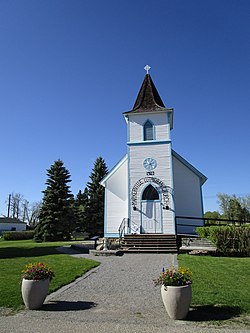Markerville is a hamlet in central Alberta, Canada within Red Deer County.[2] It is located 4 kilometres (2.5 mi) north of Highway 54, approximately 29 kilometres (18 mi) southwest of Red Deer.
Markerville | |
|---|---|
 Markerville Lutheran Church, built in 1907 | |
| Coordinates: 52°07′25″N 114°10′14″W / 52.12361°N 114.17056°W | |
| Country | Canada |
| Province | Alberta |
| Region | Central Alberta |
| Census division | 8 |
| Municipal district | Red Deer County |
| Government | |
| • Type | Unincorporated |
| • Governing body | Red Deer County Council |
| Area (2021)[1] | |
| • Land | 0.17 km2 (0.07 sq mi) |
| Population (2021)[1] | |
• Total | 38 |
| • Density | 219.8/km2 (569/sq mi) |
| Time zone | UTC−07:00 (MST) |
| • Summer (DST) | UTC−06:00 (MDT) |
| Area code(s) | 403, 587, 825 |
Markerville was the home for many years of Stephan G. Stephansson, famous in modern Icelandic literature,[3] whose home is preserved as an Alberta Provincial Historic Site.[4]
Demographics
editIn the 2021 Census of Population conducted by Statistics Canada, Markerville had a population of 38 living in 17 of its 18 total private dwellings, a change of -15.6% from its 2016 population of 45. With a land area of 0.17 km2 (0.066 sq mi), it had a population density of 223.5/km2 (578.9/sq mi) in 2021.[1]
As a designated place in the 2016 Census of Population conducted by Statistics Canada, Markerville had a population of 45 living in 19 of its 22 total private dwellings, a change of 7.1% from its 2011 population of 42. With a land area of 0.19 km2 (0.073 sq mi), it had a population density of 236.8/km2 (613.4/sq mi) in 2016.[14]
See also
editReferences
edit- ^ a b c d "Population and dwelling counts: Canada and designated places". Statistics Canada. February 9, 2022. Retrieved February 10, 2022.
- ^ "Specialized and Rural Municipalities and Their Communities" (PDF). Alberta Municipal Affairs. June 3, 2024. Retrieved June 14, 2024.
- ^ Ross, Jane (2005). "Stephansson, Stephan Gudmundur". In Cook, Ramsay; Bélanger, Réal (eds.). Dictionary of Canadian Biography. Vol. XV (1921–1930) (online ed.). University of Toronto Press.
- ^ Stephan G. Stephansson House. Canadian Register of Historic Places.
- ^ 1971 Census of Canada: Population (PDF). Special Bulletin: Unincorporated Settlements. Vol. Bulletin SP—1. Ottawa: Statistics Canada. 1973. Retrieved September 25, 2024.
- ^ "Geographical Identification and Population for Unincorporated Places of 25 persons and over, 1971 and 1976". 1976 Census of Canada (PDF). Supplementary Bulletins: Geographic and Demographic (Population of Unincorporated Places—Canada). Vol. Bulletin 8SG.1. Ottawa: Statistics Canada. 1978. Retrieved September 26, 2024.
- ^ 1981 Census of Canada (PDF). Place name reference list. Vol. Western provinces and the Territories. Ottawa: Statistics Canada. 1983. Retrieved September 26, 2024.
- ^ 1986 Census of Canada (PDF). Population. Vol. Unincorporated Places. Ottawa: Statistics Canada. 1988. Retrieved September 26, 2024.
- ^ 91 Census (PDF). Population and Dwelling Counts. Vol. Unincorporated Places. Ottawa: Statistics Canada. 1993. Retrieved September 26, 2024.
- ^ 96 Census (PDF). A National Overivew: Population and Dwelling Counts. Ottawa: Statistics Canada. 1997. Retrieved September 26, 2024.
- ^ "Population and Dwelling Counts, for Canada, Provinces and Territories, and Census Divisions, 2001 and 1996 Censuses - 100% Data (Alberta)". Statistics Canada. August 15, 2012. Retrieved September 19, 2024.
- ^ "Population and dwelling counts, for Canada, provinces and territories, and designated places, 2006 and 2001 censuses - 100% data (Alberta)". Statistics Canada. July 20, 2021. Retrieved September 19, 2024.
- ^ "Population and dwelling counts, for Canada, provinces and territories, and designated places, 2011 and 2006 censuses (Alberta)". Statistics Canada. February 8, 2012. Retrieved September 19, 2024.
- ^ a b "Population and dwelling counts, for Canada, provinces and territories, and designated places, 2016 and 2011 censuses – 100% data (Alberta)". Statistics Canada. February 8, 2017. Retrieved February 13, 2017.

